Related Research Articles

Hatshepsut was the Great Royal Wife of Pharaoh Thutmose II and the fifth Pharaoh of the Eighteenth Dynasty of Egypt, ruling first as regent, then as queen regnant from c. 1479 BC until c. 1458 BC. She was Egypt's second confirmed queen regnant, the first being Sobekneferu/Nefrusobek in the Twelfth Dynasty.
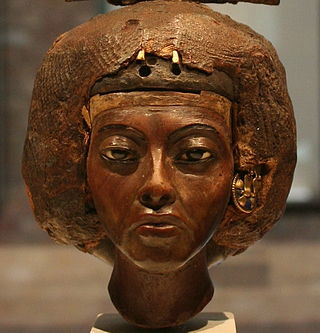
Tiye was the Great Royal Wife of the Egyptian pharaoh Amenhotep III, mother of pharaoh Akhenaten and grandmother of pharaoh Tutankhamun; her parents were Yuya and Thuya. In 2010, DNA analysis confirmed her as the mummy known as "The Elder Lady" found in the tomb of Amenhotep II (KV35) in 1898.
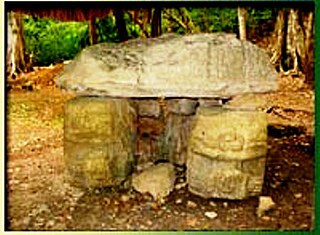
El Perú, is a pre-Columbian Maya archeological site occupied during the Preclassic and Classic cultural chronology periods. The site was the capital of a Maya city-state and is located near the banks of the San Pedro River in the Department of Petén of northern Guatemala. El Perú is 60 km (37 mi) west of Tikal.
Fu Hao died c. 1200 BC, posthumous temple name Mu Xin (母辛), was one of the many wives of King Wu Ding of the Shang dynasty and also served as a military general and high priestess. Minimal evidence detailing Fu Hao's life and military achievements survived the Shang dynasty, and the records may have perished over the course of time.
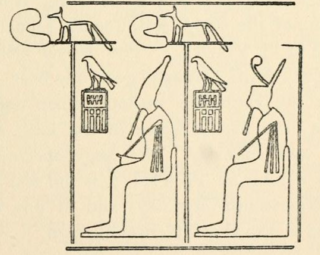
Djer is considered the third pharaoh of the First Dynasty of ancient Egypt in current Egyptology. He lived around the mid 31st century BC and reigned for c. 40 years. A mummified forearm of Djer or his wife was discovered by Egyptologist Flinders Petrie, but was discarded by Émile Brugsch.

Tomb KV42 is an ancient Egyptian tomb in the Valley of the Kings near Luxor, Egypt. It was constructed for Hatshepsut-Meryetre, the wife of Thutmose III, but she was not buried in the tomb. It may have been reused by Sennefer, a mayor of Thebes during the reign of Amenhotep II, and by several members of his family. The tomb has a cartouche-shaped burial chamber, like other early Eighteenth Dynasty tombs.
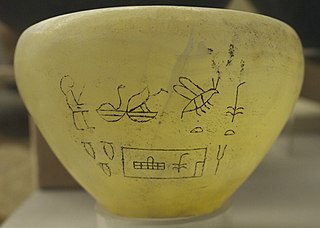
Semerkhet is the Horus name of an early Egyptian king who ruled during the First Dynasty. This ruler became known through a tragic legend handed down by the historian Manetho, who reported that a calamity of some sort occurred during Semerkhet's reign. The archaeological records seem to support the view that Semerkhet had a difficult time as king and some early archaeologists questioned the legitimacy of Semerkhet's succession to the Egyptian throne.
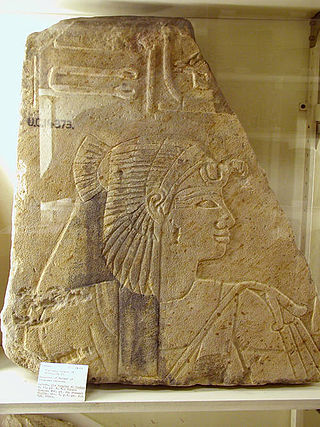
Sitamun, also Sitamen,Satamun; Ancient Egyptian: sꜣ.t-imn, "daughter of Amun" was an ancient Egyptian princess and queen consort during the 18th Dynasty.

Nimaathap was an ancient Egyptian queen consort at the transition time from 2nd Dynasty to 3rd Dynasty. Nimaathap may have acted as regent for her son Djoser.

Menhet, Menwi and Merti, also spelled Manhata, Manuwai and Maruta, were three minor foreign-born wives of Pharaoh Thutmose III of the Eighteenth Dynasty. They are known for their lavishly furnished rock-cut tomb in Wady Gabbanat el-Qurud near Luxor, Egypt. They are suggested to be Syrian, as the names all fit into Canaanite name forms, although their ultimate origin is unknown. A West Semitic origin is likely, but both West Semitic and Hurrian derivations have been suggested for Menwi. Each of the wives bear the title of "king's wife", and were likely only minor members of the royal harem. It is not known if the women were related as the faces on the lids of their canopic jars are all different.

Sithathoriunet was an Ancient Egyptian king's daughter of the 12th Dynasty, mainly known from her burial at El-Lahun in which a treasure trove of jewellery was found. She was possibly a daughter of Senusret II since her burial site was found next to the pyramid of this king. If so, this would make her one of five known children and one of three daughters of Senusret II—the other children were Senusret III, Senusretseneb, Itakayt and Nofret.
Neferthenut was an ancient Egyptian queen of the Twelfth Dynasty of Egypt. She was most likely the wife of Senusret III.
Aat was a queen of the ancient Egyptian 12th Dynasty. Of all the wives of Amenemhat III, only her name is known to modern archaeology with any certainty.
Khenemetneferhedjet II(Weret) was an ancient Egyptian queen of the 12th Dynasty, a wife of Senusret III.

Mentuhotep was an ancient Egyptian queen of the Second Intermediate Period, wife of pharaoh Djehuti. Her main title was Great Royal Wife. Another title was Khenemetneferhedjet.

Sithathor was an ancient Egyptian princess with the title king's daughter. She is only known from her burial at Dahshur. Next to the pyramid of king Senusret III were found underground galleries as a burial place for royal women. Most of the burials were found looted, but there were two boxes for jewellery overlooked by tomb robbers. Both boxes contained an outstanding collection of jewellery. They were called the first and the second treasure of Dahshur. The first treasure was discovered on 6 March 1894 and belonged most likely once to Sithathor. Several scarabs with her name were found. The treasure contained a pectoral with the names of king Senusret II, one of the masterpieces of Egyptian goldwork. Other objects were golden shells, golden bracelets, a mirror and several stone vases. Sithathor is not known for sure outside her tomb. She was perhaps a daughter of Senusret III, but it is also possible that she was the daughter of Senusret II and buried as sister of king Senusret III next to him. The other box to a king's daughter with the name Mereret or Meret.
Khentkaus III, often called Khentakawess III by news media, was an ancient Egyptian queen who lived during the Fifth Dynasty, around 2450 BC.

The pyramid of Senusret III is an ancient Egyptian pyramid located at Dahshur and built for pharaoh Senusret III of the 12th Dynasty.

The Statuette of the lady Tiye is a wooden statue of a high-status woman from the reign of Amenhotep III to Akhenaten ; Dynasty 18 of the New Kingdom of ancient Egypt. Believed to depict a leading servant of the powerful Great Royal Wife Tiye, her title has been variously translated over the years as "Chief of Weavers" / "Chief of the Household" / "mistress of the harim". It is one of only about 160 wooden statues discovered from the New Kingdom. It currently resides in the Metropolitan Museum of Art.

The Queens' Tombs at Nimrud are a set of four tombs discovered by Muzahim Hussein at the site of what was once the ancient Assyrian city of Nimrud. Once the capital of the Neo-Assyrian Empire, Nimrud was located on the East bank of the Tigris river, in what would be modern day Northern Iraq. Nimrud became the second capital of the Assyrian empire during the ninth century BCE, under Assurnasirpal II. Assurnasirpal II expanded the city and built one of the most significant architectural achievements at Nimrud, the Northwest Palace––bētānu in Assyrian. The palace was the first of many built by Neo-Assyrian rulers, and it became a template for later palaces. During an excavation of the Northwest Palace in 1988, the Queen's Tombs were discovered under the Southern, domestic wing. All four tombs discovered within the palace were built during the ninth and eighth centuries and were primarily constructed of the mudbrick, baked brick, and limestone ––materials commonly used in Mesopotamian architecture. The architecture of the tombs as well as the Northwest Palace within which they are housed provide historical insight into the Assyrian Empire's building techniques. The most notable items found within the queens' tombs included hundreds of pieces of fine jewelry, pottery, clothing, and tablets. These objects crafted by Neo-Assyrian artists would later allow archaeologists to build on their understanding of Neo-Assyrian goldsmithing techniques. Each tomb was built in advance of a queen's death and construction began as early as the 9th century under Assurnasirpal II and continued under Shalmaneser III.
References
- ↑ D. Arnold: Dahschur, Dritter Grabungsbericht, In: MDAIK 36 (1980), 20
- ↑ Silke Roth: Die Königsmütter des Alten Ägypten von der Frühzeit bis zum Ende der 12. Dynastie, Wiesbaden 2001, p. 440 ISBN 3-447-04368-7